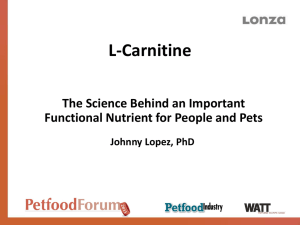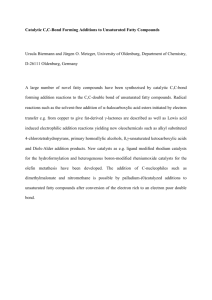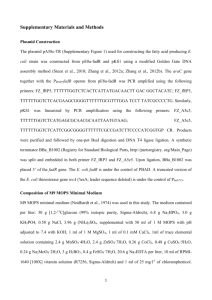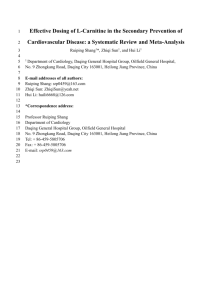The Effects of L-Carnitine and Omega
advertisement
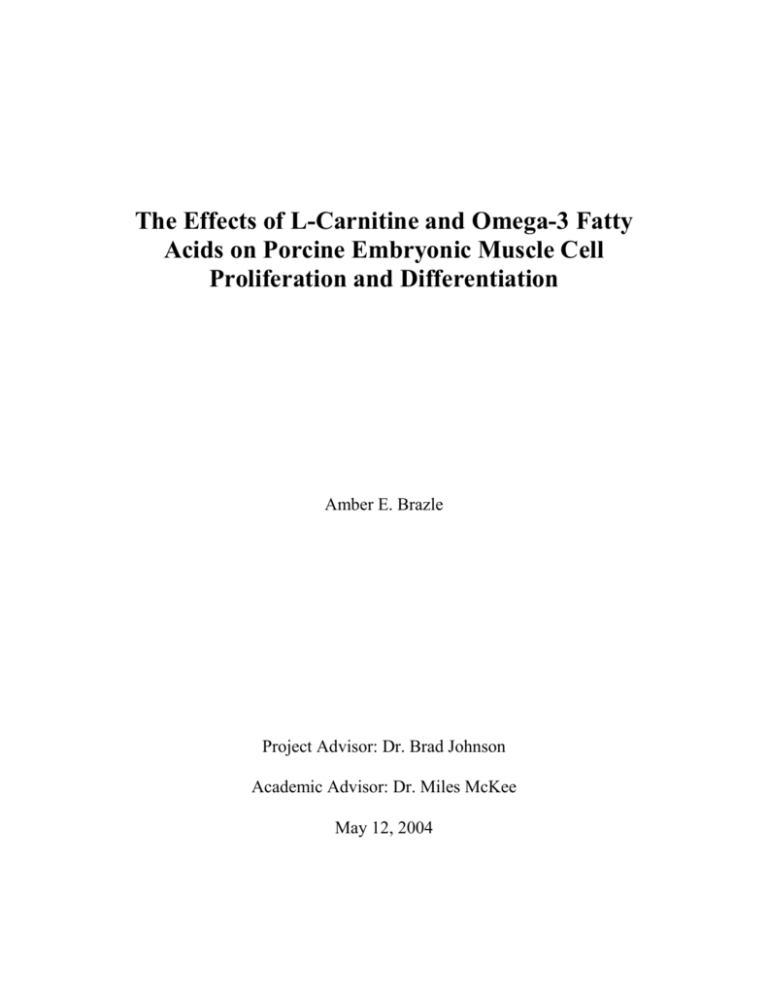
The Effects of L-Carnitine and Omega-3 Fatty Acids on Porcine Embryonic Muscle Cell Proliferation and Differentiation Amber E. Brazle Project Advisor: Dr. Brad Johnson Academic Advisor: Dr. Miles McKee May 12, 2004 The Effects of L-Carnitine and Omega-3 Fatty Acids on Porcine Embryonic Muscle Cell Proliferation and Differentiation Introduction L-Carnitine is a water-soluble vitamin-like compound that is synthesized primarily in the liver and kidney and is involved in protein and lipid metabolism. According to recent studies, supplementing sows with L-Carnitine resulted in larger-cross sectional areas of the semitendinosus muscle (Musser et al., 2001). The offspring also had larger loineye areas and higher percentages of lean tissue (Musser et al., 1999). Additional studies by Eder et al., 2001, suggest that the number of non-viable pigs will decrease and the fetuses will have heavier birth weights. Omega-3 fatty acids are essential polyunsaturated fatty acids (PUFAs) that cannot be synthesized in the body. Alpha-linolenic acid is an eighteen-carbon fatty acid with three double bonds. Omega 3 fatty acids make the blood less likely to form clots that cause heart attacks and protect against irregular heartbeats that cause sudden cardiac death (Harris et al., 2002). This study was designed to determine the interactive effects of Omega-3 fatty acids, specifically, linolenic acid, on porcine embryonic muscle cell proliferation and differentiation in cells isolated from fetal pigs at mid gestation from sows fed L-Carnitine as compared to cultures established from sows receiving no supplemental L-Carnitine during gestation. Using muscle cultures for research is beneficial to the scientific world by reducing the number of live research subjects required to determine the effects of a compound on muscle growth and differentiation. Therefore, evaluating the effect of L- Carnitine and Omega-3 fatty acids on porcine embryonic muscle growth and differentiation will be used to determine more efficient swine production methods as well as increase the nutritional value of pork. Materials and Methods Porcine embryonic muscle cells were obtained by completing hysterectomies on sows at mid-gestation. The fetal pigs were removed under aseptic conditions and transported to a laminar hood. Myogenic muscle cells were isolated, suspended in solution, and stored in liquid nitrogen. Ann Waylan performed this portion of the procedure in her Ph.D. research on the effects of supplementing L-Carnitine on the IGF systems in porcine embryonic myoblasts. Each week for six weeks, the same procedures were used each day. The cells from one control and one L-Carnitine sow were plated and processed each week. Prior to plating the cells, it was necessary to provide a foundation for the cells to be plated on. On Day 1, a mixture of matri gel and serum free Dulbecco’s Modified Eagle Medium (SF/DMEM) with antibiotics and gentamicin was plated at 0.25 mL on three wells of two-four well plates, 0.25 mL on fifteen wells of a twenty-four well plate, and 0.50 mL on six wells of two-six well plates. The antibiotics and gentamicin were added to prevent unwanted contamination. The matri gel solution was allowed to set up for one hour in an incubator. Excess solution was aspirated off and warm SF/DMEM media was added. The four well plates were to establish a 24 hour count, the six well plates were for the differentiation studies, and the twenty-four well plate was to measure thymidine incorporation with and without the fatty acid in the sows fed L-Carnitine as well as those not receiving the L-Carnitine supplementation. On Day 2, cells were taken from the liquid nitrogen tank and added to 15 mL of 10% Fetal Bovine Serum (FBS)/DMEM with the antibiotic and gentamicin. Fetal Bovine Serum contains all of the necessary growth factors and nutrients. This solution was centrifuged for ten minutes. The media was aspirated off of the pellet and 25 mL of the 10% FBS/DMEM media was added. This was vortexed and triturated to ensure even distribution of the cells during plating. Two mL of the cell solution was plated on the two-six well plates, one plate per sow, and 1 mL to three wells of the four well plates as well as six wells per sow on the twenty-four well plate. All plates were incubated at thirty-seven degrees Celsius in a carbon dioxide incubator. Day 3 involved rinsing each of the wells and adding fresh media, providing nutrients to the cells. The twenty-four hour count was taken on the four well plates. The test media with the alpha-linolenic acid was added to three wells of the six well plates and to three wells of each sow on the twenty-four well plates. Control media was added to the remaining wells. Tritiated thymidine was added to fifteen wells of the twenty-four well plate on Day 5. Tritiated thymidine is an indicator of the rate of cell proliferation. The two sixwell plates were rinsed and swine serum/DMEM with the additional antibiotic and gentamicin was applied with the test and control media to the respective wells. (Porcine embryonic muscle cells differentiate better in swine serum.) After three hours, the twenty-four well plate with the tritiated thymidine was rinsed with cold SFDMEM, and 1 mL of cold 5% trichloroacetic acid (TCA) was added. The TCA releases the unincorporated tritiated thymidine so it can be removed. The seventy-two hour count was taken from three fields of the three control wells for each animal. The muscle cells on the wells with alpha-linolenic acid were too numerous to count. On the next day, 1 uL of Ara-C was applied directly to the wells on the two-six well plates. Ara-C inhibits all cell division, but differentiation could still occur. The twenty-four well plate was rinsed with 5% TCA, and 0.5 mL of NaOH was added to each well. The plate was incubated for thirty minutes. Afterwards, the contents of each well were added to a vial with 10 mL of scintillation fluid. The wells were rinsed with 1 mL of the scintillation fluid that was also added to the vials. Vials were vortexed and counted for thymidine incorporation. The last stage of the process was to stain the two-six well plates. This enabled pictures to be taken of the myotube formation and fusion. Five pictures were taken for each well, and each picture was counted for multi-nucleated cells. Fusion is a marker of differentiation. It is standard procedure to use this measure to estimate the degree of differentiation. Results and Discussion The following results are numerically based, not statistical. These data suggest numerically that supplementing L-Carnitine to the gestating sow increased the proliferation of cells at twenty-four hours. (See Figure 1.) These data are consistent with previous studies in our laboratory (Waylan, 2003). It also appeared that Omega-3 fatty acids may increase myotube numbers at 120 hours in both control and L-Carnitine cells. However, the degree of differentiation in L-Carnitine cells with and without the fatty acid was higher than the control with the fatty acid added. The L-Carnitine with the fatty acid treatment had a 15.8% increase over the control wells with the fatty acid. The L-Carnitine wells without the fatty acid added had an 11.4% increase over the control wells lacking the fatty acid. (See Figure 2.) An increase in the number of doublings between twenty-four and seventy-two hours was observed in the sows fed L-Carnitine. (See Figure 3.) This too is consistent with Ann’s data. Thymidine incorporation measures the rate of proliferation. The measure of thymidine incorporation suggested that the control cells may have had a greater rate of proliferation at seventy-two hours. (See Figure 4.) Conclusions The data show numerical differences in proliferation of the cells isolated from the sows supplemented with L-Carnitine during gestation as well as an increase in the number of doublings between twenty-four and seventy-two hours in the sows fed LCarnitine. It also appeared, numerically, that Omega-3 fatty acids may increase the degree of differentiation at 120 hours in both the control and treatment groups. These findings contribute to our understanding of porcine fetal growth and development. Acknowledgements The author would like to thank Ann Waylan for the cell collection work and for guidance provided throughout the study. Thanks are also extended to the College of Agriculture Honors Program and to the Department of Animal Science. References Eder, K., A. Ramanau, and H. Kluge. 2001. Effect of L-Carnitine supplementation on performance parameters in gilts and sows. J. Anim. Physiol. a. Anim. Nutr. 85:73-80. Harris, William S. and Lawrence J. Appel. Nov. 2002. American Heart Association, New guidelines focus on fish, fish oil, omega-3 fatty acids. Musser, R.E., R.D. Goodband, M.D. Tokach, K.Q. Owen, J.L. Nelssen, S.A. Blum, S.S. Dritz, and C.A. Civis. 1999b. Effects of L-carnitine fed during gestation and lactation on sow and litter performance. J. Anim. Sci. 77:3289-3295. Musser, R.E., R.D. Goodband, K.Q. Owen, D.L. Davis, M.D. Tokach, S.S. Dritz, and J.L. Nelssen. 2001. Determining the effect of increasing L-carnitine additions on sow performance and muscle fiber development of the offspring. J. Anim. Sci. 79(Suppl. 2):65 (Abstr). Waylan, Ann. 2003. Effects of L-carnitine on fetal growth and the IGF system in pigs. (Dissertation). Figures Effect of Treatment on Average Number of Cells per cm2 at 24 Hours 2500 2000 1500 1000 500 0 Control L-Carnitine Figure 1: Number of cells at twenty-four hours. Effect of Treatments on Myotube 2 Numbers per cm at 120 Hours 600 500 400 300 200 100 0 With Fatty Acid Figure 2: Number of myotubes at 120 hours. Without Fatty Acid Effect of Treatment on Number of Doublings 2.25 2.2 2.15 2.1 2.05 2 1.95 Control L-Carnitine Figure 3: Number of doublings. Effect of Treatments on 3 [ H]thymidine Incorporation per Cell 0.4 0.3 50.3 0.2 50.2 0.1 50.1 0.0 5 0 With Fatty Acid Figure 4: Thymidine incorporation per cell. Without Fatty Acid Pictures of Cell Cultures 24 Hours L-Carnitine with Fatty Acid 72 Hours L-Carnitine without Fatty Acid Control with Fatty Acid Control without Fatty Acid



